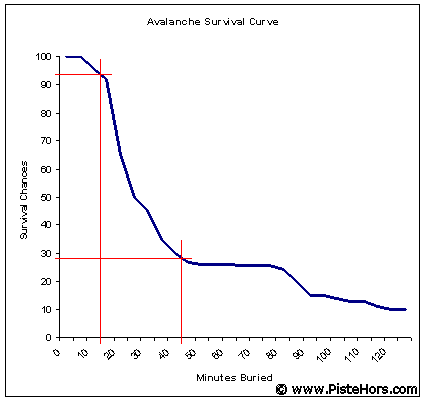
Avalanches > Search and Rescue > Avalanche Survival Curve
Researchers using data gathered by the Swiss Avalanche Research Center at Davos for accidents between 1981 and 1991 have plotted the survival probability of a victim buried under snow against time. This figures show that of 123 skiers dug out of an avalanche during the first 15 minutes of burial only 8 were dead with 6 having sustained injuries as a result of the avalanche itself.
This figure was quite surprising for researchers, despite advances in medicine and search and rescue such as the widespread introduction of Recco equipment the death rate from avalanches remains fairly constant at around 25-30 per year in France or around 60% of victims on extraction. This is largely due to the average response time of the search and rescue services which is 45 minutes in France. This is the time to process the emergency call, warm the motor of a helicopter, fly to and locate the scene of the accident then deploy the search and rescue services. Two thirds of avalanche victims will succumb in that critical half hour.

Avalanche Survival Curve
The FFME (French Mountaineering Federation) maintains a list of phone numbers for the Mountain Police (PGHM) and CRS. This is quicker than passing through the international emergency number (112). You will need to give your location and the number of victims when you call.
In the first 15 minutes 93% of avalanche victims are still alive, indeed most of the deaths occur during the fall either by hitting rocks or trees or being carried over cliffs or by being crushed or suffocated by the weight of snow. Wet snow avalanches, characteristic of spring, are most likely to suffocate or crush skiers during this phase but it is less common for skiers to be caught these.
In this half hour period, two thirds of victims will die from asphyxiation. Apart from wet snow avalanches the snow encasing victims contains a significant amount of oxygen and is permeable. If a victim has protected or can clear airways and can breath (that is the weight of snow is not compressing the lungs or thorax) they can usually breath. During this period the surrounding air will either be exhausted or the victims respiration will condense and freeze slowly rendering the surrounding snow impermeable.
Between 45 minutes and rescue the victim will probably have found an air pocket and is in a phase of relative security which will allow them to survive for a considerable period. Death is either from slow asphyxia or hypothermia. With an adequate air supply hypothermia is slowed down.
Between being rescued and arrival and recovering in hospital the risk of hypothermia is great. Hypothermia begins when the body temperature drops below 35 C (body temperature is around 37C) and it is extremely rare for a victim to survive once their body temperature drops to 29C. The survival phase is critical, when the body is cooled it will divert blood from the extremities to the vital organs, when the body is warmed blood will return to the extremities but at too low a temperature this will cool the vital organs causing death by thermal shock.
In an off-piste accident in the Sept Laux ski station on the 27/01/2001 two victims were rescued during this period by the emergency services but succumbed later in Grenoble hospital.
The basic message is that to survive an avalanche you have to be rescued within 15 minutes, with half an hour to wait before the rescue services arrive on the scene this comes down to your friends. Your life depends on carrying and being proficient in the use of avalanche transceivers and having snow probes and shovels. In ideal conditions it will take around 5 minutes to locate a victim with a transceiver and 10 to 15 minutes to dig them out from the average depth of burial which is 1 meter.
However these figures shouldn't create a false sense of security. In an exercise the author performed with the large Davos rescue services it took 45 minutes to locate and find 5 victims in an avalanche site using transceivers, dogs and probes. If you follow the rules you should never have more than 1 person caught in an avalanche but you may have to climb back up to rescue them which will waste precious minutes and energy.